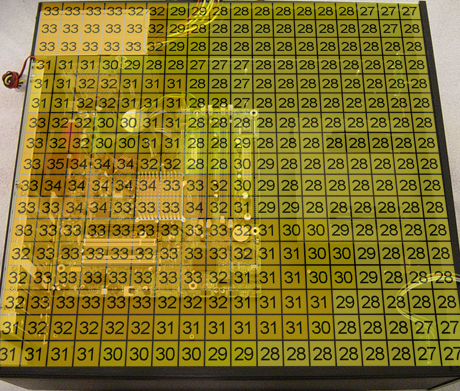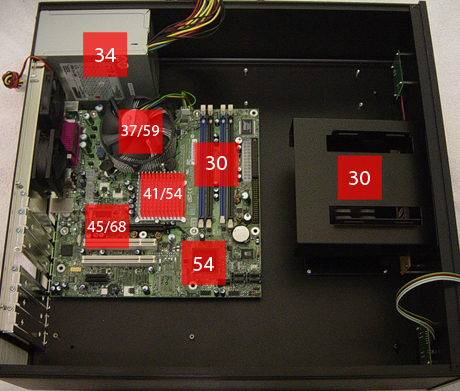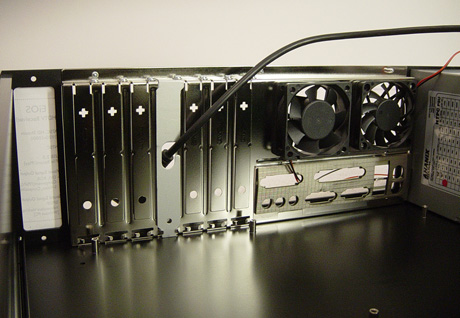Intel's Long Awaited BTX Form Factor
by Purav Sanghani on November 15, 2004 5:31 AM EST- Posted in
- Cases/Cooling/PSUs
Thermals Desktop ATX
We tested our D915GUX board and Pentium 550 CPU in Ahanix's D.Vine 5 HTPC chassis, the successor to the D.Vine 4 we reviewed last month, since it had the size of a typical mid tower case yet took on the form of a flat lying desktop case like the B300 to give a better idea of how this hardware performed in a case with sizes we are used to. Unlike Opus Technologies, Ahanix has a great deal of products, many of them cases which is their main focus. The first case we reviewed from Ahanix was their Black Knight. The Black Knight performed well in our thermal benchmarks while averaging at 50dBA in sound We again measure temperatures of the ambient air inch by inch to show how each component affects various areas of the case.
Click to Enlarge
It is evident that the warmest region in our desktop ATX system is between the CPU, Northbridge, and PCIe VGA card followed by the power supply. We also notice how the rear exhaust fans are pulling the warm air towards them to the outside. The D.Vine 5 has an extremely large footprint, 17" in width by 18" in depth, so there are many areas which are not being exposed to warm air such as the front corners as well as the left side of the case.

Click to Enlarge
We see here that the CPU, Northbridge heatsink and the PCIe VGA card are the hottest components in the system. The Southbridge also ran extremely hot at 54 degrees, but it is too small to have as great of an effect on the ambient air around it as did the other three. The power supply, on the other hand, measured to be 34 degrees which had a great affect on its surrounding air.

Click to Enlarge
Again, since the D.Vine 5 lies flat instead of upright like the TT-501 does, heat pockets mainly occur over the equipment giving off the heat instead of at the top of the case (the right side in this case) near the power supply.










77 Comments
View All Comments
trikster2 - Tuesday, November 16, 2004 - link
I've got to say, this review is bad, even by anandtech standards.
Comparing an mBTX destop to a mATX TOWER to a Fullsize ATX desktop, litteraly comparing apples to oranges to pears, and then coming to sweeping conclusions like "any of us were skeptical for a long time, but after seeing the numbers ... we can conclude that BTX is not hype. " is simply ludicrouse.
Shame on you anand for letting such a review fall through your QC into the hands of the general public.
I'm not sure if you guys are incompetent or payed by intel to find a combo to pimp the BTX standard. I just did a refresh 5 times, no intel adds so it must be the former.
How about spending 49.95 on a decent desktop mATX case and compare apples to apples, instead of just grabbing whatever was laying around the lab (we've seen that whacked oppus case in other reviews haven't we?)?
I have the silverstonetek equivalent of the oppus matx tower. It is the worst mATX cases I have ever worked with. Give us a break and do a valid review, mATX single fan 1/2 height desktop to mBTX single fan 1/2 height desktop.
johnsonx - Tuesday, November 16, 2004 - link
I see nothing here in the BTX standard that couldn't have been better accomplished with a backwards and forwards compatible ATX II standard.ATX II compliant motherboards would have standardized locations for the CPU socket, two standard locatations for RAM (either or both locations could be used, as needed), standard locations for the power connectors, standard locations for the most common onboard ports (IDE, SATA, front USB, audio, etc.) and standard component heights (capacitors and etc.).
ATX II compliant cases would have standardized air intake and exhaust locations, fan mounts, and ducting. ATX II cases could be built to open from the right side, with the CPU on the bottom. The ducting would be removeable for use with a legacy ATX mainboard.
ATX II compliant heatsinks would be fanless, designed to be cooled by an ATX II chassis duct, but would have a fan mounting point for use in a legacy ATX chassis. Boxed coolers that come with retail CPU's would include the fan on a standard clip with instructions to remove it when used with an ATX II compliant chassis and mainboard.
ATX II compliant power supplies would basically be the same as the latest ATX supplies are now - 24pin power, 8-pin ATX 12v power, standard 4-pin drive power plugs, SATA power plugs, PCI-E graphics power plug. 24 to 20 pin converters and 8-pin to 4-pin converters would be standard with retail power supplies.
Any mix of ATX and ATX II components would work fine together, but a system built of all ATX II components would gain various cooling, noise level, assembly and operational advantages.
What does BTX offer that my hypothetical ATX II standard doesn't? Oh, yeah... ATX II couldn't give you a face of hot air...
xsilver - Monday, November 15, 2004 - link
To the guy b4 that was wondering where the air intakes are -- no amount of case fans are going to create a vacum inside your case, there's just not enough pressure -- unless you tape up all the gaps lol.... so the air will just "flow" in from any holes in your caseblackmetalegg - Monday, November 15, 2004 - link
Bah we're(work) using this motherboard in an application that shall remain anonymous(NOT oridinary PC) and the damn design make wiring a bitch to deal with. And the motherboard isn't all that stable, considering it's from Intel...justly - Monday, November 15, 2004 - link
BTW that 20.666715 "cfm" is assuming all of the area taken by the 2 fans has air flow, but we should all knoe that the motor and frame ocupy some of that space so the actual "cfm" would be lower.justly - Monday, November 15, 2004 - link
Why was "lfm" not converted to "cfm" for a direct comparison on page 11?If I am reading this correctly the BTX provides 40 "cfm" while the ATX requires 150 "lfm". This sounds like BTX is an overwhelming success, untill you do the conversion that is. So what exactly does this 150 "lfm mean in comparison, well if the ATX uses 2-80mm fans that would be 80mm x 80mm = 6400 square mm per fan, 6400 x 2 = 12800 square mm for both fans, convert that to square ft and you get 0.1377781 square ft, take that and multiply by the 150 "lfm" and we get (drum roll) 20.666715 "cfm". Thats right about half what the BTX has.
I don't know if this was intentional or not, but I will give the author the benifit of the doubt and assume it was not.
If I have overlooked something please explain my mistake, if not then I feel some injustice has been done to the readers that did not ask this question.
ShadowVlican - Monday, November 15, 2004 - link
like someone else said... the BTX form wasn't made for enthusiasts, since we already know how to cool our rigs properly..BTX is for the average consumer who doesn't know jack about computers, so BTX will help those people have quieter/cooler computers without them reading forums/articles
i'm just wondering how well the transition from ATX machines into BTX will go...
ZobarStyl - Monday, November 15, 2004 - link
Yes Five40, you can't directly upgrade from 754 to 939, but you can take your case and PSU with you...I'm using the same case I used in my AXP system now for an A64 with watercooling, but if Intel has their way, my next rig won't be able to use the same rig and I'll just have to spend more cash. Hence, we are rightfully pissed because the real question is "Why?" and when something lacks benefits but costs you mad cash: a whole new case and good PSU will set me back 120 bucks, for what? Nothing worth my time.MAValpha - Monday, November 15, 2004 - link
Anyone know how pBTX stacks up against FlexATX?five40 - Monday, November 15, 2004 - link
#50....umm I can't do a A64 to A64 upgrade so what's your point? 754 to 939 does me no good. I just see this as another socket update. A64 might not need it right now, but if all things where just made for what we need right now, we'll move forward at a very slow pace.